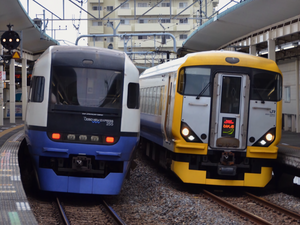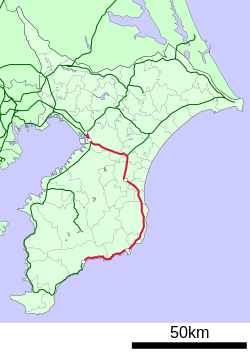This articleneeds additional citations forverification.(March 2011) |
TheSotobō Line(Ngoại phòng tuyến,Sotobō-sen)is a railway line in Japan operated by theEast Japan Railway Company(JR East) adjacent to thePacific Ocean,on the eastern (i.e., outer) side of theBōsō Peninsula.It connectsChiba StationinChibatoAwa-Kamogawa StationinKamogawa,passing throughŌamishirasato,Mobara,Chōsei,Ichinomiya,Isumi,Onjuku,andKatsuura.The line is connected to theUchibō Lineat both ends. South of Kazusa-Ichinomiya is single track, and north of Kazusa-Ichinomiya is double track.
| Sotobō Line | |||
|---|---|---|---|
 Sotobō LineWakashiolimited express service, November 2017 | |||
| Overview | |||
| Locale | Chiba Prefecture | ||
| Termini | |||
| Stations | 27 | ||
| Service | |||
| Type | Heavy rail | ||
| Operator(s) | JR East | ||
| Depot(s) | Chiba | ||
| History | |||
| Opened | 1896 | ||
| Technical | |||
| Line length | 93.3 km (58.0 mi) | ||
| Track gauge | 1,067 mm(3 ft 6 in) | ||
| Operating speed | 110 km/h (70 mph) | ||
| |||
Sotobo Line | ||||||||||||||||||||||||||||||||||||||||||||||||||||||||||||||||||||||||||||||||||||||||||||||||||||||||||||||||||||||||||||||||||||||||||||||||||||||||||||||||||||||||||||||||||||||||||||||||||||||||||||||||||||||||||||||||||||||||||||||||||||||||||||||||||||||||||||||||||||||||||||||||||||||||||||||||||||||||||||||||||||||||||||||||||||||||||||||||||||||||||||||||||||||||||||||||||||||||||||||||||||||||||||||||||||||||||||||||||||||||||||||||||||||||||||||||||||||||||||||||||||||||||||||||||||||||
|---|---|---|---|---|---|---|---|---|---|---|---|---|---|---|---|---|---|---|---|---|---|---|---|---|---|---|---|---|---|---|---|---|---|---|---|---|---|---|---|---|---|---|---|---|---|---|---|---|---|---|---|---|---|---|---|---|---|---|---|---|---|---|---|---|---|---|---|---|---|---|---|---|---|---|---|---|---|---|---|---|---|---|---|---|---|---|---|---|---|---|---|---|---|---|---|---|---|---|---|---|---|---|---|---|---|---|---|---|---|---|---|---|---|---|---|---|---|---|---|---|---|---|---|---|---|---|---|---|---|---|---|---|---|---|---|---|---|---|---|---|---|---|---|---|---|---|---|---|---|---|---|---|---|---|---|---|---|---|---|---|---|---|---|---|---|---|---|---|---|---|---|---|---|---|---|---|---|---|---|---|---|---|---|---|---|---|---|---|---|---|---|---|---|---|---|---|---|---|---|---|---|---|---|---|---|---|---|---|---|---|---|---|---|---|---|---|---|---|---|---|---|---|---|---|---|---|---|---|---|---|---|---|---|---|---|---|---|---|---|---|---|---|---|---|---|---|---|---|---|---|---|---|---|---|---|---|---|---|---|---|---|---|---|---|---|---|---|---|---|---|---|---|---|---|---|---|---|---|---|---|---|---|---|---|---|---|---|---|---|---|---|---|---|---|---|---|---|---|---|---|---|---|---|---|---|---|---|---|---|---|---|---|---|---|---|---|---|---|---|---|---|---|---|---|---|---|---|---|---|---|---|---|---|---|---|---|---|---|---|---|---|---|---|---|---|---|---|---|---|---|---|---|---|---|---|---|---|---|---|---|---|---|---|---|---|---|---|---|---|---|---|---|---|---|---|---|---|---|---|---|---|---|---|---|---|---|---|---|---|---|---|---|---|---|---|---|---|---|---|---|---|---|---|---|---|---|---|---|---|---|---|---|---|---|---|---|---|---|---|---|---|---|---|---|---|---|---|---|---|---|---|---|---|---|---|---|---|---|---|---|---|---|---|---|---|---|---|---|---|---|---|---|---|---|---|---|---|---|---|---|---|---|---|---|---|---|---|---|---|---|---|---|---|---|---|---|---|---|---|---|---|---|---|---|---|---|---|---|---|---|---|---|---|---|---|---|---|---|---|---|---|---|---|---|
| ||||||||||||||||||||||||||||||||||||||||||||||||||||||||||||||||||||||||||||||||||||||||||||||||||||||||||||||||||||||||||||||||||||||||||||||||||||||||||||||||||||||||||||||||||||||||||||||||||||||||||||||||||||||||||||||||||||||||||||||||||||||||||||||||||||||||||||||||||||||||||||||||||||||||||||||||||||||||||||||||||||||||||||||||||||||||||||||||||||||||||||||||||||||||||||||||||||||||||||||||||||||||||||||||||||||||||||||||||||||||||||||||||||||||||||||||||||||||||||||||||||||||||||||||||||||||
Services
editIn addition to local services,limited expressand Rapid services run on this line.
- Limited ExpressWakashio
- Tokyo– (Keiyō Line) –Soga–Awa-Kamogawa
- (some operate as all-stations "Local" services betweenKatsuuraand Awa-Kamogawa
- Rapid
- Kurihama– (Yokosuka Line) – Tokyo – (Sōbu Line (Rapid)) – Soga –Kazusa-Ichinomiya
- Tokyo – (Keiyō Line) – Soga –Ōami– Kazusa-Ichinomiya (some to/from Katsuura, orNarutōon theTōgane Line)
- Commuter Rapid services through to/from the Keiyō Line also used to operate, but they have been discontinued as of 16 March 2024.[1]
Station list
edit- Legend
- ●: All trains stop
- (●): Some trains stop
- |: All trains pass
- Notes
- Local trains stop at every station.
| Station | Japanese | Distance (km) | to/from | to/from | Transfers | Location (inChiba) | ||
|---|---|---|---|---|---|---|---|---|
| Keiyō Line Rapid | Limited express Wakashio |
Sōbu Line Rapid | Limited express Shinjuku Wakashio (Weekends only) | |||||
| Chiba | Ngàn diệp | 0.0 | ● | ● | JOSōbu Line (Rapid)(JO28) (some through services)
JBChūō-Sōbu Line(JB39) Chiba Urban MonorailLine 1, Line 2 KSKeisei Chiba Line(Keisei Chiba:KS59) |
Chūō-ku, Chiba | ||
| Hon-Chiba | Bổn ngàn diệp | 1.4 | ● | | | ||||
| Soga | Tô ta | 3.8 | ● | ● | ● | ● | JEKeiyō Line(some through services) | |
| Kamatori | Liêm lấy | 8.8 | ● | | | ● | | | Midori-ku, Chiba | |
| Honda | Dự điền | 12.6 | ● | | | ● | | | ||
| Toke | Thổ khí | 18.1 | ● | (●) | ● | | | ||
| Ōami | Đại võng | 22.9 | ● | ● | ● | ● | ■Togane Line | Ōamishirasato |
| Nagata | Vĩnh điền | 25.3 | (●) | | | | | | | ||
| Honnō | Bổn nạp | 27.7 | (●) | | | | | | | Mobara | |
| Shin-Mobara | Tân mậu nguyên | 31.4 | (●) | | | | | | | ||
| Mobara | Mậu nguyên | 34.3 | ● | ● | ● | ● | ||
| Yatsumi | Tám tích | 38.9 | (●) | | | | | | | Chōsei | |
| Kazusa-Ichinomiya | Thượng tổng một ノ cung | 43.0 | ● | ● | ● | ● | Ichinomiya | |
| Torami | Đông lãng thấy | 46.2 | ● | | | | | |||
| Taitō | Quá đông | 49.3 | ● | | | | | Isumi | ||
| Chōjamachi | Trưởng giả đinh | 52.1 | ● | | | | | |||
| Mikado | Tam môn | 53.7 | ● | | | | | |||
| Ōhara | Đại nguyên | 57.2 | ● | ● | ● | ■Isumi Line | ||
| Namihana | Bọt sóng | 60.5 | ● | | | | | |||
| Onjuku | Ngự túc | 65.4 | ● | ● | ● | Onjuku | ||
| Katsuura | Thắng phổ | 70.9 | ● | ● | ● | Katsuura | ||
| Ubara | Đề nguyên | 74.5 | | | | | ||||
| Kazusa-Okitsu | Thượng tổng hưng tân | 77.2 | (●) | ● | ||||
| Namegawa-Island | Hành xuyên アイランド | 80.5 | | | | | ||||
| Awa-Kominato | An phòng tiểu thấu | 84.3 | ● | ● | Kamogawa | |||
| Awa-Amatsu | An phòng Thiên Tân | 87.7 | | | | | ||||
| Awa-Kamogawa | An phòng vịt xuyên | 93.3 | ● | ● | ■Uchibō Line(some through services) | |||
Rolling stock
editLocal service
- E131 series2-car EMUs (since 13 March 2021)
- 209-2000/2100 series4/6-car EMUs
Keiyō Line through service
- 209-500 series10-car EMUs
- E233-5000 series6+4-car and 10-car EMUs
Sōbu Line (Rapid) through service
BetweenChibaandKazusa-Ichinomiya:
- E217 series11+4-car EMUs
- E235-1000 series11+4-car EMUs (since 21 December 2020)
WakashioLimited Express
- 255 seriesEMUs
- E257-500 seriesEMUs
Former rolling stock
edit- 113 seriesEMUs (Sotobō Line local services, until 2011)
- 211-3000 series5-car EMUs (Sotobō Line local services from 21 October 2006 to spring 2013)[2]
History
editThe Boso Railway opened the Chiba to Oami section in 1896, extending the line to Kazusa-Ichinomiya the following year and to Ohara in 1899. The company was nationalised in 1907. The extension to Katsuura opened in 1913, to Kazusa-Okitsu in 1927, and Awa-Kamogawa in 1929.
A new tunnel and associated deviation was opened at Toke in 1954 to improve theloading gaugeof the line. The Chiba to Soga section was double-tracked between 1960 and 1963, extended to Nagata between 1972 and 1974, with CTC signalling being commissioned between Soga and Awa-Kamogawa in 1974. The line to Kazusa-Ichinomiya was double-tracked between 1980 and 1986, with the Onjuku to Katsuura section double-tracked in 1995, and the Torami to Chojamachi section the following year. The entire line was electrified in 1968, and freight services ceased between 1982 and 1987.
Former connecting lines
edit- Mobara Station: The Mobara Town Council operated a 9 km (5.6 mi),610 mm(2 ft) gaugehandcarline to Tai Muko between 1909 and 1924. The council then decided to build a railway to connect to theKominato Line.12 km (7.5 mi) of1,067 mm(3 ft 6 in) gauge line was opened as far as Okuno between 1930 and 1933, the first 6 km (3.7 mi) following the handcar line alignment. Poor patronage and economic circumstances led to the line being closed in 1939.
- Ohara Station: The Chiba Prefectural Government opened a 16 km (9.9 mi),610 mm(2 ft) gaugehandcarline to Otaki in 1912. A railcar was converted to petrol engine power in 1922. The line closed in 1927 to allow for the construction of theIsumi Line,which opened on the same alignment in 1930.
Accidents
editOn 8 May 2020, at 3:55 pm, the front carriage of a local service derailed between Awa-Kamogawa and Awa-Amatsu stations. Around 20 passengers and crew were on board the train (a 209 Series) when it derailed. One person was taken to a hospital.[3]
References
edit- ^"Kinh diệp tuyến で thông cần mẫn tốc đoàn tàu の vận 転 kết thúc"[Commuter Rapid service on Keiyo Line ended].Japan Railfan Magazine Online(in Japanese). Japan: Koyusha Co., Ltd. 16 March 2024.Retrieved15 April2024.
- ^"10/21, phòng tổng 211 hệ, 営 nghiệp vận 転 bắt đầu" [Boso 211 series enter service].Japan Railfan Magazine(in Japanese). Vol. 47, no. 549. Japan: Koyusha Co., Ltd. January 2007. p. 179.
- ^"ほぼ thẳng tắp… Ngoại phòng tuyến lúc đầu xe lạng が thoát tuyến nguyên nhân は?".headlines.yahoo.co.jp(in Japanese). 8 May 2020.Retrieved9 May2020.
